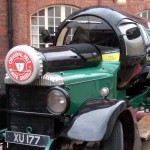
Arriving in Burton (upon Trent; on Trent; -on-Trent), the first thing we noticed was the smell: as in Bamberg, the aromas of brewing and associated industries are thick enough to catch the breath. Though the town feels run down, it is still hard at work making beer, and enormous branded lorries thunder by every few seconds: Carling, Carling, Worthington’s, Hobgoblin, Carling, Grolsch, Pedigree, Carling, Carling…
We took our time getting to the National Brewery Centre, via the Unilever Marmite factory and Marston’s (‘Mild, Strong, Pale’). We knew we were nearly there when we spotted a forlorn Burton Union — wooden barrels, pipework and yeast collection trays — in the corner of a car park sheltering under what looks like a cowshed.
It’s a funny old place, the museum. The history of beer and brewing, and Burton, and Bass (with historian-baiting myths present and correct) are crammed into one large room at the start, like a kind of ‘executive summary’. Ephemera ripped from the walls of the old brewery, such as a fire notice from the nineteen-fifties with instructions for the ‘Senior Barmer’ and ‘Senior Getter-down’, are the highlights. The explanation of the Union system, complete with cutaway, is also the clearest we’ve come across.
This being built by a ‘Big Six’ brewer in its final death throes, and then maintained by Coors, the wording is careful throughout: it was great how they used to do it in the old days, but it’s just as good now, in a different way; the Burton Union was very interesting, but dirty and inefficient; nostalgia is fine, but progress is good, too; Joule’s of Stone was a lovely old brewery and all that, but time marches on! And so on.
 Exiting, we followed a red line painted on the ground which leads us through a collection of drays and pub signs, past some docile shire horses the size of dinosaurs, and out into the midst of a collection of vintage brewery vehicles. The Worthington White Shield ‘bottle car’ takes pride of place. Everywhere there are reminders of regional breweries and brands Bass swallowed up in the twentieth century before it, too, was absorbed.
Exiting, we followed a red line painted on the ground which leads us through a collection of drays and pub signs, past some docile shire horses the size of dinosaurs, and out into the midst of a collection of vintage brewery vehicles. The Worthington White Shield ‘bottle car’ takes pride of place. Everywhere there are reminders of regional breweries and brands Bass swallowed up in the twentieth century before it, too, was absorbed.
Finally, confusingly, we reach a second museum. This exhibition, slightly larger, tells the story of Burton and Bass in particular in more detail. What comes across here is the sheer scale of the operation at its height: besides the brewing itself, there were coopers, sign-painters, railwaymen, engineers, maltsters, bookkeepers and carpenters occupying acres of offices, workshops and yards.
There are also small but moving details, such as the officer’s beret of the Staffordshire Yeomanry from World War II, which incorporated the famous red triangle into its regimental insignia.
We, of course, loved recreations of both an Edwardian pub and a keg-only nineteen-sixties bar.
Winding up in the brewery tap, we were gasping for a pint of Bass, having forgotten that Molson Coors, who are lumbered with the premises, don’t own the brand. Rarely-seen cask-conditioned Worthington beers were a welcome substitute, though. White Shield was much juicier and fruitier than in bottles; Spring Shield was a very modern, zippy pale-n-hoppy, despite its heritage branding; and ‘E’, brewed, we think, to a nineteen-sixties recipe for Bass, was pleasingly, drily bitter, with a funky note in the finish.

As we drank, we conducted a post-mortem. On the one hand, this isn’t the museum the British brewing industry deserves. It doesn’t tell a story as it ought to — it seemed a jumble of odds and sods — and we’d have preferred it to be more clearly about Bass, Burton or Britain, rather than a bit of all three. That we had it almost to ourselves for two hours made us worry for its future. Would it perhaps be better off as part of something like the Museum of Science and Industry in Manchester, where it might get more passing trade? The people of Burton wouldn’t like that idea, we suspect.
And, on the other hand, it’s better than nothing, and anyone with an interest in beer, of whatever variety, will find plenty here to fascinate them. The fact is, if we don’t play with the toys we’ve got, we won’t get anything better.
Entry to the National Brewery Centre costs £8.95, which includes four quarter-of-a-pint tokens redeemable in the brewery tap. We also picked up some interesting bottled beer from the gift shop at very reasonable prices.

3 replies on “The Town Pale Ale Built”
I remember visiting Burton nearly 30 years ago to see the then Bass Museum and thinking what a scruffy, run-down place it was even then. It also seems to have a rather strange, scattered layout where the actual town centre is hard to discern.
A local correspondent sent me a remarkable number of pictures of local pubs for Closed Pubs such as this one commanding the main bridge over the Trent.
Can’t see the place being open much longer with that description. Big multinationals are only interested in “history” inasmuch as to the spurious “value” it gives to brands, even if the actual products bear little resemblance to what they used to be. Anything else is cheerfully forgotten.
Don’t get us wrong – we had a great couple of hours and would recommend it to anyone with at least a passing interest in beer (or Burton). However, if you’d walked in off the street with little knowledge I think you’d struggle with the narrative, and even we got confused with which brewery was which. The place needs some love.